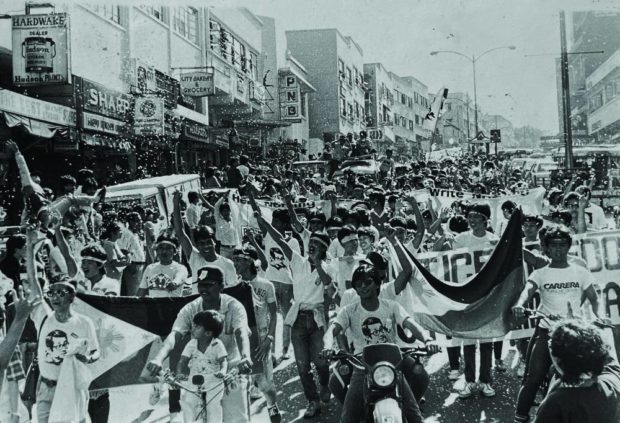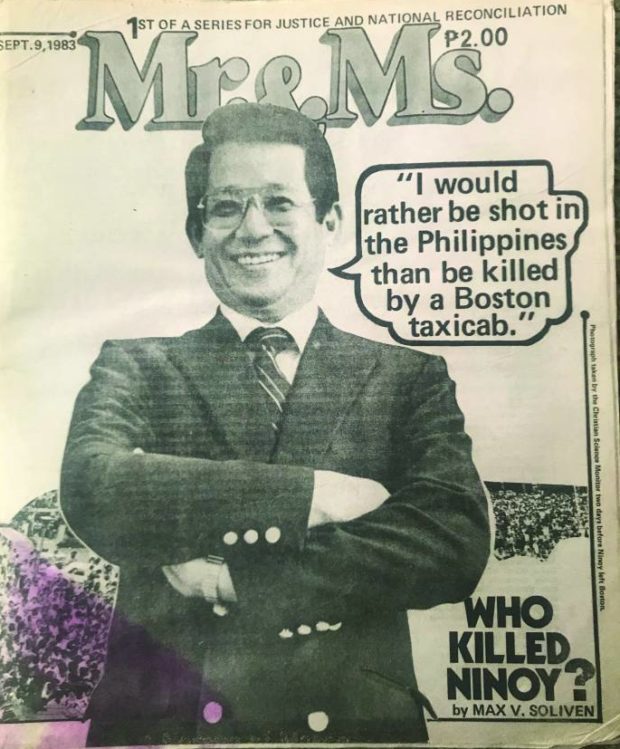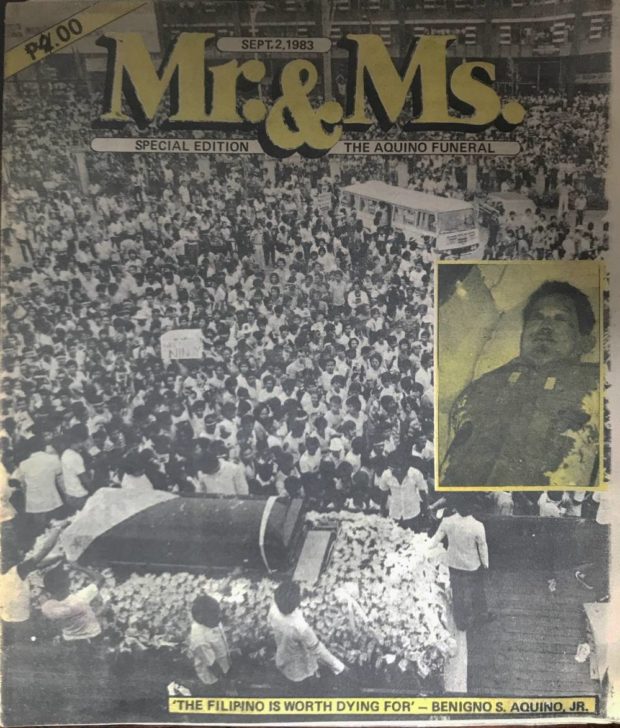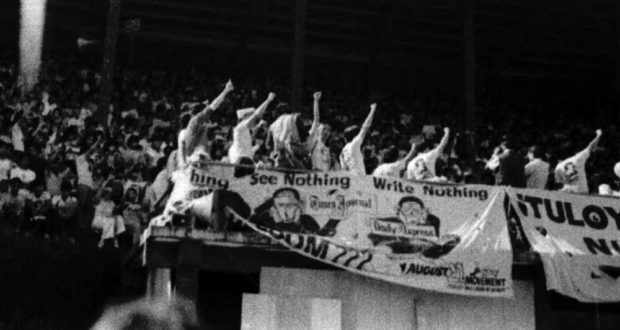Aug. 21, 1983: ‘History can’t be erased’

Ninoy Rally in Baguio 1984 (Photo by JOEL ARTHUR TIBALDO)
BAGUIO CITY, Benguet, Philippines — When former Sen. Benigno “Ninoy” Aquino Jr. was felled by an assassin’s bullet at the Manila International Airport on Aug. 21, 1983, Baguio residents went out into the streets in outrage, much like the rest of the country.
Many residents here shared a deep foreboding about the fate of Aquino when the leading figure of the political opposition fighting the dictatorship of Ferdinand Marcos Sr. decided to fly home from the United States.
The Official Gazette, the official journal of the Philippine government, described Aquino, who served as senator during the 7th Congress, as “the major political rival of President Ferdinand Marcos, and was one of the first to be arrested after the abolition of Congress [when Marcos declared Martial Law on Sept. 21, 1972].”
“[Ninoy] was put through a military trial, charged with murder, illegal possession of firearms, and subversion. He endured seven years of incarceration before he was allowed to seek medical treatment in the United States for a heart condition,” it said.
Accompanied by foreign and local journalists documenting his historic return aboard a China Airlines flight, Aquino was fetched by soldiers from the plane and was shot by an assassin, later identified as Rolando Galman, as he and his escorts were approaching the tarmac.
“[There was] no way he was going to be allowed to live. He was too big a troublemaker. He was charismatic, sharp, articulate, witty—possessed of an encyclopedic grasp of Philippine political history and social issues,” said Baguio-based lawyer Joel Dizon, a former community paper editor.
“That’s not even his worst quality, as far as his political adversary is concerned. The worst thing about him is that he peddled hope and trafficked in optimism,” added Dizon in an account he sent to the Inquirer on Tuesday.

Scanned photo from JOEL ARTHUR TIBALDO
Mosquito press
Because of widespread suspicion that Malacañang had a hand in his killing, Aquino’s death spawned a government fact-finding investigation, which was reported each day by the so-called “mosquito press,” such as the weekly magazine Mr. & Ms. Special Edition and the weekly newspaper Philippine Inquirer.
Baguio folk bought every copy that was sold at local newsstands and watering holes.
“The decade of the ’80s was a wobbly era of fitful change. Between the declaration of martial law in 1972 [and] Ninoy’s homecoming in 1983, the nation had just been through a decade of servile submission to autocratic rule,” Dizon said.
He added: “Overall, the nation was in decline. Poverty was on the rise, the pillaging of the national treasury was so blatant, thorough and systematic. Official and private crony plunder was so rampant and pervasive that corruption was the new normal, and virtue became the new sedition.”
The assassination inspired Baguio residents to join the Justice for Ninoy, Justice for All (Jaja) movement to peacefully yet forcefully renounce the cruelty and oppressiveness of the dictatorship, said Marian Catedral King, one of the Jaja Baguio chapter’s founders who was then a student at the University of the Philippines (UP) Baguio.
Aquino’s cousin, Katrina Aquino-Brickman, was also a UP Baguio student when the senator was murdered.
“I remember an eerie silence after the assassination. We were in disbelief [over] what had blatantly been done in front of us-in broad daylight and in front of the world … A band of friends, mostly students from UP, wanted to protest right there and then, so Jaja was formed to consolidate efforts from various groups [who wanted] to participate,” she said in an email. Her father, Medardo, is the youngest brother of Aquino’s mother, Doña Aurora.

Scanned photo from JOEL ARTHUR TIBALDO
Peaceful outrage
King, who was in Metro Manila when Aquino was killed, said she could not recall the exact dates as to when their group actually formed Jaja in Baguio.
“Upon our return to Baguio, [Brickman] and I started meeting with some of our UP classmates, teachers and other organizers [from September to November 1983],” she said, citing the growing anti-Marcos sentiment in Baguio following the 1980 murder of Cordillera elder, Macliing Dulag, for opposing the government’s Chico River Dam project in Kalinga.
According to King, rallies were happening in Metro Manila and one could feel the “solid north,” referring to the huge following of the Marcos family in northern Luzon, about to break its silence.
“I clearly remember ATOM Baguio (or the August Twenty One Movement) and Jaja partnering together in what must have been the longest and most well-organized motorcade and noise barrage in Baguio. Our groups just suddenly got together and agreed to have one,” she said.
Photographs compiled by local journalist Art Tibaldo of that event were dated 1984.
Brickman said she remembered the Jaja Baguio chapter rally as “one of the first—if not the first—in the country to assemble in large numbers to protest against the Marcos regime’s brutal murder of Sen. Ninoy.”

TRUTH NEVER DIES | In 1983, Baguio City became one of the centers of protests in the country as residents, led by members of the local chapter of Justice for Aquino, Justice for All (Jaja) movement, joined protest actions following the assassination of former Sen. Benigno “Ninoy” Aquino Jr. upon his return to the country. They turned to the “mosquito press” as they sought the truth behind the murder of the country’s leading anti-Marcos figure that time. Jaja staged
a rally on Ninoy’s birthday in November that year, and perhaps one of the biggest—if not the biggest—demonstrations outside Metro Manila which was organized in 1984. (Photo by JOEL ARTHUR TIBALDO)
Massive turnout
“This massive turnout in Baguio heralded a chain of simultaneous protests around the country which gave rise to People Power. One cannot deny the significance of urgent community action as superbly carried out by Jaja in the City of Pines,” she said.
Brickman said Jaja had approached a weekly newspaper, the Gold Ore, “to help publicize the effort.”
Its editor, the late Jose Nicolas “Peppot” Ilagan, advised them how to proceed with the rally because the city government had refused to give the group a permit.
King said they spent “days and nights just silkscreening Ninoy T-shirts” to raise funds for Jaja activities.
“We used to hold Betamax screenings of Ninoy’s arrival, [and showed] how he was taken from his airline seat and brought down to the tarmac. The Betamax tape was courtesy of [UP student] Nolan Sison’s dad, who made us use it to spread awareness. Things were very fluid and there was always this fear of getting picked up [by government agents],” she said.
King added: “I recall hanging around Gold Ore a lot and being with Peppot Ilagan gave us some kind of comfort. I was thinking that if I get picked up, at least someone will be able to tell my mother where I was taken.”
Student leaders of the University of Baguio, the Baguio Colleges Foundation (now the University of the Cordilleras) and Saint Louis University joined the call for joint mass actions.
According to King, commemorating Ninoy’s martyrdom will teach younger Filipinos that the liberty they enjoy “did not come cheap,” and that “history can never be changed or erased.”
In a text message from the US, Maya Villacorte-Avancena, another Jaja Baguio founder, said: “We continue to tell the stories to our children so that they know how fragile freedom is and so they will make every effort to participate in and protect their home country’s freedom.”
RELATED STORIES
Lagman recalls Plaza Miranda bombing, Aquino assassination ahead of Ninoy Aquino Day
Agrava report on Ninoy Aquino slay: Groundbreaking search for truth
Recto Mercene, 77: Newsman’s photos of Ninoy slay helped rouse nation